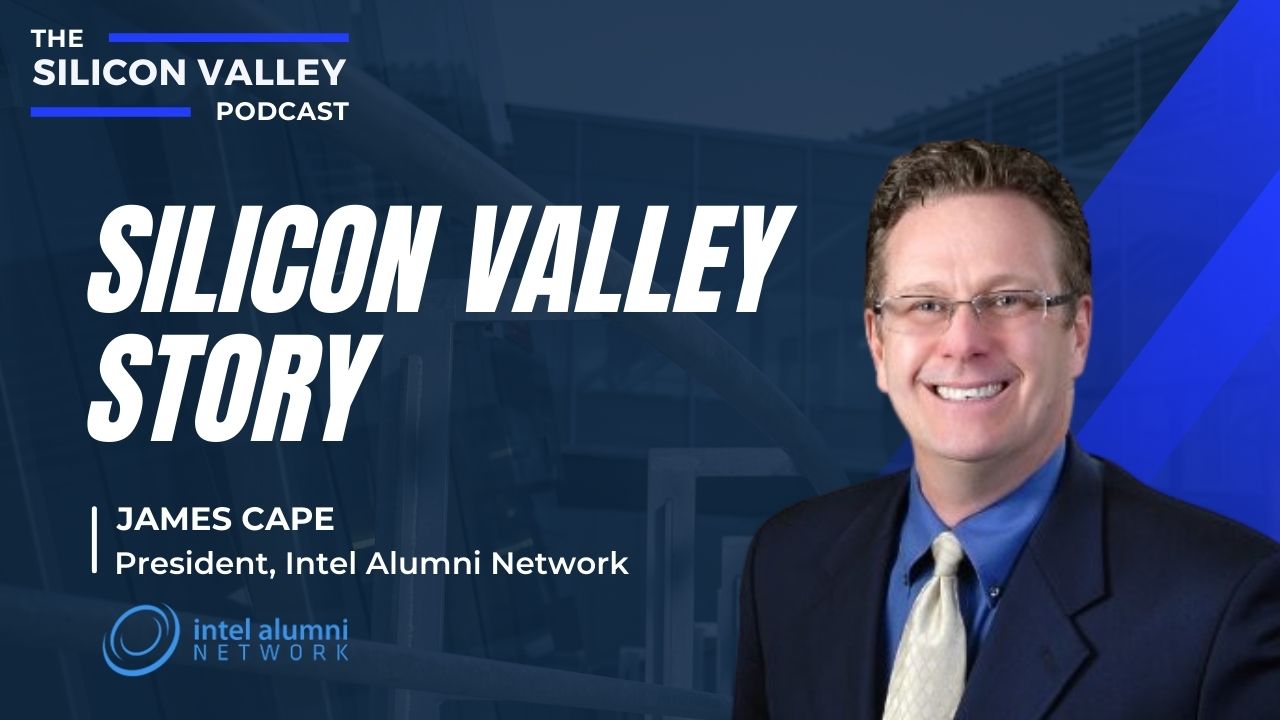Inside Silicon Valley with Intel Alumni Network’s James Cape
James has worked in the Silicon Valley high technology industry since 1983. During his first eighteen years he worked at Intel Corporation where he gained broad experience in a variety of sales, marketing, and venture capital positions.
As a Silicon Valley native (since 1960, to be precise) James Cape recounts what Silicon Valley used to be, and how it formed into the distinctive environment seen today. Once referred to as a “Valley of Heart’s Delight, with orchards for miles and miles as far as the eye could see”, Cape recalls receiving a special Silicon Valley feature copy of National Geographic in 1971. It showed an Intel executive and his wife sitting in a hot tub, sipping Chardonnay. Very hip. This was a symbolic marker of the new ethos of Silicon Valley, thanks to the rise in semiconductor companies coming out of the 60’s. Cape explains the significance of semiconductors, and their importance in military ventures. The Department of Defense and the NSA swooped in, giving Silicon Valley its “bootstraps.”
Cape notes that the ostentatious wealth that is now synonymous with Silicon Valley was not prevalent in his early life. He remembers families with fathers who were engineers, tinkering in their garages, rather than homes filled with wealthy executives. His father was one of those engineers, resulting in Cape to deviate from his line of work. The 70s was about Sex, Drugs, Rock n’ Roll, and Disco. Cape embraced the trendsetting characteristics of Silicon Valley, along with the rest of the population. Silicon Valley was doing something different. Rather than recruiting from the likes of Stanford and Berkeley, Intel and other semiconductor manufacturers were smart. They saw the explosion in employment talent, and they began to recruit talent from the likes of San Jose State, and Santa Clara. People were fighting for talent.
During this time, Cape’s father was offered not one, but two, founder’s positions at Apple. He turned them both down. He also turned down a position at Intel, pre-IPO. Cape recalls a certain energy in the air, something unpredictable. No one knew where the Silicon Valley revolution was going to go, but folks were along for the ride. Something was happening. For example, one of Intel’s founders, Gordon Moore, was asked what he thought a personal computer in the home would be good for. He responded- “It’ll help Betty organize her recipes.” This response demonstrated the lack of vision from even the most intelligent Silicon Valley PhD’s.
One product of this tech revolution was Intel’s 4004 Microprocessor, which just celebrated its 50th anniversary. It was a grouping of chips, but it was offered as a complete solution and became the prequel to 1008, 8080, and the EDA (other Intel microprocessors.) This demonstrated Intel’s ability to put microprocessors onto one neat platform, which was unprecedented at the time. Cape notes this is what sparked the revolution, and its unfolding. With the 80s came the combination of the invention of networking plus the microprocessor and software. This led to the invention of the personal computer, and Netscape going public in 1995. This is what, Cape says, invited Wall Street to play in Silicon Valley’s backyard. There was a shift, he says. It became all about money, and it became all about the IPO.
Now, Cape says, he doesn’t recognize Silicon Valley. He used to see it first hand, the sons and daughters of engineers building products that would be a betterment to humanity. Now, he says, the waters are muddied. For example, Cape cites the creation of Facebook and threats to democracy. The creation and usage of high performance computing, AI, ML, and the rise of bioscience tools like CRISPR are representative of the “next revolution”, and it isn’t slowing down anytime soon. Reflecting on archaic technologies such as the Gutenberg Press, up to the Von Neumann model, Cape articulates that the introduction of Intel’s 4004 truly represents a seminal event in information technology. To summarize, Intel was a core piece of the foundation of Silicon Valley.
Looking forward, Cape says we are getting smarter about predicting what is happening in the future. But there are also disturbances, and things like figuring out how Moore’s Law will continue into the future. Taking Moore’s Law (the performance of microprocessors doubling every two years) into consideration, Cape points to the repercussions of such fast advances. With the introduction of gene-editing technologies such as CRISPR, in addition to AI and machine learning algorithms, technology is set to become integrated into us physically. But what does this mean? Cape says it is about having discussions. Asking lawmakers intelligent questions, such as implications of blockchain technology and cryptocurrency on the US dollar, and who owns what data. Privacy, policy, security, and data ownership are increasingly important. Cape says that he has seen too many of the unintended consequences of the evolution of technology for these factors to be overlooked. He notes that information technology can creep in, and become insidious to democracy, for example. Asserting himself as a capitalist, Cape notes that he can still point out the externalities of technology, such as the burning of fossil fuels into the atmosphere. It is unhealthy for people and the planet, and Cape says that it must be considered. With this, Cape still considers Silicon Valley to be in its early evolution. Concluding the interview, Cape says that there is absolutely nothing that will get in the way of technological innovation in the next 10 years. With this developing technology, it is only up to humans to decide how it will be used. “I think cyborgs have arrived, and they are us. It’d be nice to know what they might look like in the next 10 years.”






